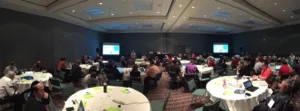Welcome to a new series that is intended to shine some light on the thinking, preferences and tendencies of your education market customers. I know them well. I was one of them. I’ve been an educational technology director for 25 years, with a significant track record in large educational technology purchases for instruction. I recently returned from the two-day FETC Executive Summit: Digital Transformation in the Age of Wireless, Wi-Fi and BYOD, held January 20-21 in sunny Orlando, Florida.
The Executive Summit is an invitation-only event for educational leaders and decision makers (superintendents, technology directors and school principals), those who are leading the charge on technology implementation. It is a sponsored event – funded by a few well-heeled companies or organizations. As with most such events, the program involved a keynote speaker, peppered with episodes of table talk, panel discussions, and one-off networking.
The FETC Executive Summit in Orlando
This event was kicked off by an enthusiastic and knowledgeable keynote speaker. A past principal, he is a cheerleader, of sorts. He described the great things his school did with technology, how rapidly his school changed, and the tremendous results his school witnessed. It all seemed like a very neat, tidy package: learning first, technology second. (That’s a nearly mythical refrain echoing in education since Microsoft founded its School of the Future in Philadelphia). But I knew something was wrong when the keynoter and the panelists to follow could not adequately answer a basic ROI question submitted to them by the audience.
And that’s where the hyperbole stopped cold in its tracks. You can’t fool educators anymore. As I moved from table to table over both days to interview leaders about their perceptions of this summit, the great majority of education market customers were taking it all with a grain of salt. The table talk was characterized neither by drooling, yearning, fawning, nor inspired delight. Rather, the leaders I interviewed were concerned with weightier questions:
Transportability. Can success with technology devices and solutions work elsewhere? Can it successfully carry over and work in my own school or my district?
Scalability. Can success with technology scale beyond a single successful school or pattern of classrooms? Is there any chance this success will scale to more classrooms or other schools in the same district? How idiosyncratic or contextual is the story I have just heard?
Sustainability. Can success with technology devices and solutions be sustained over the long haul? What happens when leaders change? When school boards change? When teachers leave? When the infatuation dies off? When newer, sexier technologies arrive, competing for our attention?
Fundability. Given limited resources and heavy competition for available dollars, how do we get things done without making hurtful compromises? Outside of the largesse of the sponsoring company give-away, how do we afford this? How do we plan for this?
You see, no one was fooled by our exuberant keynoter. Face it – cheerleading just doesn’t work well anymore. Times are too tough. Dollars are so hard to come by. Costly mistakes are hard to self-repair. The hunger pangs that grew out of the Great Recession are still painfully recent in our memories.
When display industry companies sponsor their own case studies, marketing initiatives, or live events for the education market customer, consider that the customer has changed. Be ready for the tough questions. Provide educators with your best thinking, manageable solutions, and key strategies for ensuring transportability, scalability, sustainability, and fundability. And remember: cheerleading is not what it used to be. – Len Scrogan

